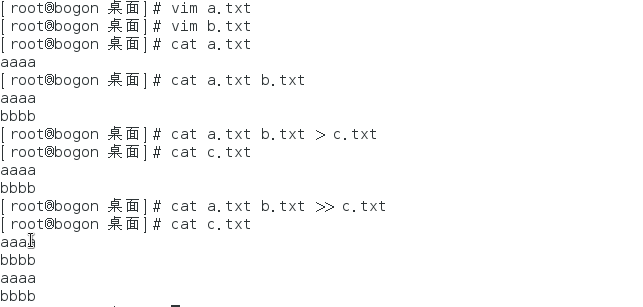使用cat命令進行文件的縱向合併,具體命令如下所示(註意:>代表將左邊命令的執行結果以覆蓋的方式放到右邊,>>代表將左邊命令的執行結果追加到右邊) 關於tar命令的一些用法: tar 命令用來將很多文件打包成一個單一的磁帶或者磁碟歸檔,並可從歸檔文件恢復出文件列表。當你需要發送大量文件時或者傳輸文件 ...
使用cat命令進行文件的縱向合併,具體命令如下所示(註意:>代表將左邊命令的執行結果以覆蓋的方式放到右邊,>>代表將左邊命令的執行結果追加到右邊)

關於tar命令的一些用法:
tar 命令用來將很多文件打包成一個單一的磁帶或者磁碟歸檔,並可從歸檔文件恢復出文件列表。當你需要發送大量文件時或者傳輸文件時非常有用。
tar 的語法:
# tar [options] file.tar file1 file2 .. .. ..
file.tar 是 tar 歸檔文件,而其他 file1 和 file2 等等是要被打包的文件。
例如我們有兩個文件 file1.txt 和 file2.txt
[root@localhost TAR]# ll total 8 -rw-r--r--. 1 root root 2770 Feb 7 22:37 file1.txt -rw-r--r--. 1 root root 887 Feb 7 22:38 file2.txt
tar 常用的使用場景
創建一個 tar 文件
語法:
# tar -cf archive.tar files .. ..
示例:
[root@localhost TAR]# tar -cf file.tar file1.txt file2.txt [root@localhost TAR]# ll file.tar -rw-r--r--. 1 root root 10240 Feb 7 22:42 file.tar
列出 tar 文件中的所有文件列表
# tar -tf archive.tar
示例:
[root@localhost TAR]# tar -tf file.tar file1.txt file2.txt
從 tar 中提取所有文件
tar -xf archive.tar
示例
[root@localhost TAR]# tar -xf file.tar [root@localhost TAR]# ll total 20 -rw-r--r--. 1 root root 2770 Feb 7 22:37 file1.txt -rw-r--r--. 1 root root 887 Feb 7 22:38 file2.txt -rw-r--r--. 1 root root 10240 Feb 7 22:42 file.tar
參數選項
1, -v, –verbose
verbosely list files processed:
Syntax:
List all files in an archive.tar verbosely:
tar -tvf archive.tar
Example:
[root@localhost TAR]# tar -tvf file.tar -rw-r--r-- root/root 2770 2014-02-07 22:37 file1.txt -rw-r--r-- root/root 887 2014-02-07 22:38 file2.txt
2, -c, –create
創建新的歸檔文件
3, -t, –list
列出歸檔文件中的內容
4, -x, –extract, –get
從歸檔中提取文件
5, -d, –diff, –compare
比較歸檔和文件系統的差異
Example:
[root@localhost TAR]# tar -tf file.tar file2.txt file3.txt file1.txt [root@localhost TAR]# tar -df file.tar file1.txt file2.txt file4.txt tar: file4.txt: Not found in archive tar: Exiting with failure status due to previous errors ----Verbosely---- [root@localhost TAR]# tar -dvf file.tar file1.txt file2.txt file2.txt file1.txt [root@localhost TAR]# tar -dvf file.tar file1.txt file2.txt file6.txt file2.txt file1.txt tar: file6.txt: Not found in archive tar: Exiting with failure status due to previous errors
6, –delete
從歸檔中刪除某文件
示例:
從歸檔 file.tar 中刪除 file1.txt
[root@localhost TAR]# tar --delete -f file.tar file1.txt [root@localhost TAR]# tar -tf file.tar file2.txt
7, -r, –append
追加文件到歸檔中
示例:
追加 file3.txt 到 file.tar
[root@localhost TAR]# tar -rf file.tar file3.txt [root@localhost TAR]# tar -tf file.tar file1.txt file2.txt file3.txt
8, -A, –catenate, –concatenate
將一個tar 歸檔追加到另外一個歸檔文件中
創建另外一個 tar 文件
[root@localhost TAR]# tar -cf archive.tar file1.txt file3.txt
追加方法:
[root@localhost TAR]# tar -Af file.tar archive.tar [root@localhost TAR]# tar -tf file.tar file2.txt file3.txt file1.txt file1.txt file3.txt
9, –test-label
測試歸檔卷標並退出
10, -u, –update
只追加最新的文件
示例:
[root@localhost TAR]# tar -tf file.tar file1.txt file2.txt [root@localhost TAR]# tar -uf file.tar file1.txt file3.txt file2.txt [root@localhost TAR]# tar -tf file.tar file1.txt file2.txt file3.txt
11, -C, –directory=DIR
更改目錄到 DIR
例如:
提取文件到另外一個目錄
[root@localhost TAR]# tar -xvf file.tar -C /root/TAR2 file1.txt file2.txt [root@localhost TAR]# cd - /root/TAR2 [root@localhost TAR2]# ll total 28 -rw-r--r--. 1 root root 23250 Feb 7 23:11 file1.txt -rw-r--r--. 1 root root 887 Feb 7 22:38 file2.txt
12, -p, –preserve-permissions
抽取文件時保留原有的文件許可權
壓縮歸檔文件,使用 BZIP 和 GZIP 兩種方法
跟壓縮相關的參數
13, -j, –bzip2
使用 bzip2 對歸檔進行壓縮
示例:
[root@localhost TAR]# tar -jcf file.tar.bz file2.txt file1.txt [root@localhost TAR]# ll total 128 -rw-r--r--. 1 root root 23250 Feb 7 23:11 file1.txt -rw-r--r--. 1 root root 887 Feb 7 22:38 file2.txt -rw-r--r--. 1 root root 30720 Feb 7 23:30 file.tar -rw-r--r--. 1 root root 1797 Feb 7 23:42 file.tar.bz
請看,上面的文件大小通過 BZIP 降低到 1797 位元組。
14, -z, –gzip
使用 gzip 壓縮歸檔
示例:
[root@localhost TAR]# tar -zcf file.tar.gz file2.txt file1.txt [root@localhost TAR]# ll total 132 -rw-r--r--. 1 root root 23250 Feb 7 23:11 file1.txt -rw-r--r--. 1 root root 887 Feb 7 22:38 file2.txt -rw-r--r--. 1 root root 30720 Feb 7 23:30 file.tar -rw-r--r--. 1 root root 1797 Feb 7 23:42 file.tar.bz -rw-r--r--. 1 root root 1673 Feb 7 23:45 file.tar.gz


